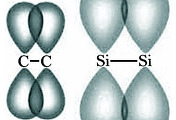할로겐 이원자분자의 물리적 상태
---------------------------------------------------
▶ 참고: 제22장 비금속 화학. 목차
[ https://ywpop.tistory.com/19820 ]
---------------------------------------------------
▶ 자연 상태에서 할로겐은
2개의 할로겐 원자가 공유결합한 이원자분자로 존재한다.
( 참고 https://ywpop.tistory.com/2984 )

[ 그림 출처 Wikimedia ] The two fluorine atoms form a stable F2 molecule by sharing two electrons.

[그림] F + F → F2.
( 참고: 공유결합 https://ywpop.tistory.com/2566 )
▶ 할로겐 이원자분자간 작용하는 힘 = London 분산력
( 참고: London 분산력 https://ywpop.tistory.com/2585 )
▶ London 분산력은 물질의 몰질량에 비례.
> 몰질량이 가장 큰 I2는 상온에서 고체 상태로 존재.
| 몰질량 | 녹는점 | 물리적 상태 | |
| F2 | 38.00 g/mol | –220℃ (53 K) | 기체 |
| Cl2 | 70.91 g/mol | –101℃ (172 K) | 기체 |
| Br2 | 159.81 g/mol | –7.2℃ (265.8 K) | 액체 |
| I2 | 253.81 g/mol | 113.5℃ (386.5 K) | 고체 |




[ 그림 출처 commons.wikimedia.org ] From left to right: chlorine, bromine, and iodine at room temperature. Chlorine is a gas, bromine is a liquid, and iodine is a solid. Fluorine could not be included in the image due to its high reactivity.
▶ 분자간 힘과 물질의 끓는점
분자간 힘(인력)이 증가할수록(클수록),
물질의 녹는점, 끓는점도 비례하여 증가한다.
즉, 분자간 힘과 녹는점, 끓는점은 비례한다.
( 참고: 분산력과 끓는점 https://ywpop.tistory.com/2587 )
[ 관련 글 https://ywpop.tistory.com/23755 ] Cl2 분자보다 I2 분자가 더 많이 보이는 이유
[ 관련 글 https://ywpop.tistory.com/20029 ] 할로겐의 전자배치
[ 관련 글 https://ywpop.blogspot.com/2024/07/chemical-properties-of-halogens.html ]
할로젠족의 화학적 성질. 할로겐족의 화학적 성질
[키워드] 할로겐 기준, 할로겐 사전, 할로겐족 기준, 할로겐족 사전
'일반화학 > [22장] 비금속 화학' 카테고리의 다른 글
| 공유결합 분자 모형. 할로겐 이원자분자 (0) | 2020.05.21 |
|---|---|
| 수소 화합물, 수소화물 (Hydrides) (0) | 2020.03.16 |
| 금속탄화물과 물의 반응식 (0) | 2020.02.20 |
| 수소 원자는 별난 녀석 (2) | 2018.08.25 |
| 공기의 분리. 질소 제조. 산소 제조 (0) | 2017.11.27 |
| 2주기와 3주기 원소의 π 결합 (1) | 2017.07.23 |
| 산성산화물, 염기성산화물, 양쪽성산화물 ★ (0) | 2017.04.11 |
| 인의 분자식. 황의 분자식. P4와 S8 (0) | 2017.03.27 |



댓글